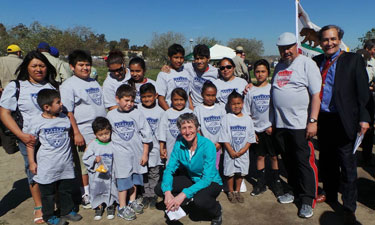 The National Park Service’s (NPS) final “Rim of the Valley Corridor Special Resources” study recommends Congress expand the Santa Monica Mountains National Recreation Area (SMMNRA) to better serve urban populations while expanding habitat connections in the Los Angeles region. The study recommends adding 177,000 acres, stretching easy access to park lands into the heart of Los Angeles, along the L.A. River and east to the San Gabriel Mountains. NPS’s work is a best-practice example for people and parks to promote NRPA’s Three Pillars: Social Equity, Conservation, and Health and Wellness.
The National Park Service’s (NPS) final “Rim of the Valley Corridor Special Resources” study recommends Congress expand the Santa Monica Mountains National Recreation Area (SMMNRA) to better serve urban populations while expanding habitat connections in the Los Angeles region. The study recommends adding 177,000 acres, stretching easy access to park lands into the heart of Los Angeles, along the L.A. River and east to the San Gabriel Mountains. NPS’s work is a best-practice example for people and parks to promote NRPA’s Three Pillars: Social Equity, Conservation, and Health and Wellness.
Increasing Access
For NPS Director Jon Jarvis, “Access to quality parks, open space and public lands with their many benefits are an essential component of social equity. Just as there are urban ‘food deserts,’ lacking fresh and healthy groceries, there are also communities, especially those in lower-income neighborhoods, that do not have access to parks.”
David Szymanski, NPS superintendent, says, “The SMMNRA is one of the three most urban NPS units, along with Golden Gate NRA and Harbors of New York NRA. SMMNRA was created to have a national-level investment in outdoor recreation for the region. That was really the goal. Rim of the Valley takes it even further.”
The NPS study documents that there are not enough parks in the region, especially for children of color and low-income children. Related health disparities from inactivity include diabetes and obesity. Environmental justice and civil rights laws require agencies to alleviate these concerns.
Congressman Raul Grijalva (D-AZ-3), ranking member on the U.S. House Committee on Natural Resources, held a forum in L.A. last year with seven members of Congress on complying with civil rights and environmental justice laws, and diversifying the mainstream environmental movement. NPS sets the standard for federal, state and local park and recreation agencies to do what’s best for all, not just the lucky few who live near mountains, beaches, rivers and lakes.
Benefiting Communities
Community leader Raúl Macias wants NPS to get the work done. United States Secretary of the Interior Sally Jewell joined Macias and the children of his Anahuak Youth Sports Association along the L.A. River in 2014. What came of that meeting? “Nothing yet,” he sighs. What would he like to see? “Transit to trails, beaches and mountains. Youth jobs to start park careers. Contracts for our families to work with NPS.”
Many inner-city children live within an hour of the mountains and beaches, but have never visited either. Director Jarvis vows to change that. “One year ago, President Obama launched Every Kid in a Park, with the goal of getting every fourth grader in the nation on a field trip to a park. We grant them a free pass to all the National Parks for the fourth grader and their family for a year!” Still, that’s not enough if you don’t have access to a car, so Every Kid provides transportation grants to schools that serve low-income students. Superintendent Szymanski says, “SMMNRA will spend $160,000 to bring about 14,000 fourth graders and 3,000 children and their families to their parks — almost all from underserved schools and communities.”
Once people get to the parks, however, they have to feel welcome. NPS is relying on education programs in schools and parks, and diversifying staff through urban youth jobs. NPS will double educational services in 2016. It doubled youth hiring to 22 people last year, and will continue that in 2016, according to Szymanski.
Macias worries about drought and climate change. He worries about gentrification. His neighbors fought epic battles for park lands to revitalize the L.A. River and in the Baldwin Hills in historic African-American L.A. As neighborhoods become greener, more desirable and more expensive, current residents will no longer be able to live or even work nearby. Rising rents for homes and small businesses lead to displacement. “It’s all part of social, health, environmental and economic inequality,” Macias says. That’s why Macias and his neighbors advocate for affordable housing for all, green jobs paying a living wage and a truly progressive income tax. Nonprofits led by people of color, where justice and health are part of the culture, must be part of this work.
The NPS studies for the Rim of the Valley, the $1.4 billion U.S. Army Corps of Engineers plan to revitalize the L.A. River, the U.S. Forest Service planning process for the San Gabriel Mountains National Monument and the U.S. Department of Housing and Urban Development’s work on parks and housing — these public works give people hope for equitable, healthy communities in which to live and raise children.
What’s next? According to Congressman Adam Schiff (D-CA-28), “Los Angeles is notoriously park-poor. In expanding the SMMNRA, we will be taking a significant step in helping to rectify this deficiency” for all Angelenos. “The next big step is writing legislation that will reflect both the [NPS] recommendations as well as the wishes of the community. And frankly, the more input we have from the community, the better the legislation we’ll be able to present to Congress.”
Special thanks to the NPS Core Study Team for its assistance with this article.
Robert García is the Founding Director and Counsel of The City Project, a nonprofit environmental justice and civil rights organization based in Los Angeles.

